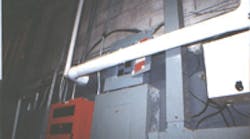As usual, never consider the following commentary associated with these photos as a formal interpretation of the National Electrical Code (NEC). The following scenarios present us with serious electrical safety questions. Please note: All Code references come from the 2002 NEC.
Alan D. Avery, P.E., of Nealis Engineering, discovered this violation while working at a school in Michigan. The equipment is located in the school's boiler room. The insulated hot water line ran in front of an electrical panel and a section of wireway. The pipe installers left the panel door open to allow access to the circuit breakers, but the wireway cover is difficult to remove. This installation violates the rules of Secs. 110.26 for access and 378.3, which states installations of wireways must comply with the applicable provisions of Art. 300.
These service entrance conductors serve two interior, mezzanine-mounted switchboards — one rated 2,000A and the other rated 4,000A. The most interesting thing about this picture is the method used to “train” and/or restrain the service conductors as they exit the conduits. It appears nothing was done to seal the ends of the conduits to prevent water from directly entering the tops of the conduits. Sec. 230.8 states: “Where a service raceway enters a building or structure from an underground distribution system, it shall be sealed in accordance with 300.5(G). Spare or unused raceways shall also be sealed. Sealants shall be identified for use with the cable insulation, shield, or other components.”
While performing some troubleshooting work, Arthur Williams, an electrician with C.R. Electric Co. of Indianapolis, noticed water flowing out of this 2-in. conduit body. Notice the drain line installed specifically for the conduit body. This installation violates Sec. 300.6. In addition, the missing cover on the conduit body is a violation of Sec. 314.15.
or the Pump?
Bryan Zapf, P.E., of Forney Engineering, Bradenton, Fla., discovered this installation at a motel in Manatee County, Fla. Twenty utility meters are located behind this 10-hp pump and piping system. A 1,200A, 120/208V main switchboard is located to the left, and to the right are some subpanels. Although not visible in this photo, the equipment at both ends of this area is too close to the piping system. In addition, holes have been drilled in the floor in place of a plumbed drain. This installation violates Table 110.26(A)(1), which requires a 3-ft operation and maintenance zone around electrical equipment.
You can send Code Violations Illustrated stories and photos directly to Joe Tedesco at:
Joe Tedesco
350 North Street
Boston, MA 02113
or e-mail: [email protected]
If you mail pictures, please include the story, location, and some information about yourself — and please do not write on the front or back of your photo. Please send all digital images in JPEG format. You can send photos while visiting Joe's Web site at: www.joetedesco.com







